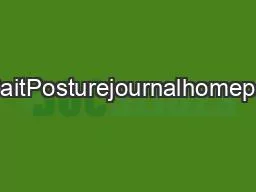

BalanceandthebrainAreviewofstructuralbraincorrelatesofposturalbalanceandbalancetraininginhumansOliviaJSurgentOlgaIDadalkoCorrespondingauthoratWaismanCenterUniversityofWisconsinMadison1500HighlandAven ID: 888719
Download Pdf The PPT/PDF document "ContentslistsavailableatGaitPosturejourn..." is the property of its rightful owner. Permission is granted to download and print the materials on this web site for personal, non-commercial use only, and to display it on your personal computer provided you do not modify the materials and that you retain all copyright notices contained in the materials. By downloading content from our website, you accept the terms of this agreement.
1 ContentslistsavailableatGait&Posturejour
ContentslistsavailableatGait&Posturejournalhomepage:www.elsevier.com/locate/gaitpost Balanceandthebrain:AreviewofstructuralbraincorrelatesofposturalbalanceandbalancetraininginhumansOliviaJ.Surgent,OlgaI.Dadalko Correspondingauthorat:WaismanCenter,UniversityofWisconsin-Madison,1500HighlandAvenue,Room435Madison,WI53705,UnitedStates.E-mailaddress:(B.G.Travers). populations.Indoingso,weexpecttoidentifypossiblebiomarkerstofacilitateearlydetectionofbalancechallengesandtolaytheground-workforecaciousinterventions.Apreviousreviewoftheeectsofbalancetrainingonspinalandsupraspinalexcitability[]suggestedthatbalancetrainingreducesspinalreexexcitabilityandcorticalinvolvementduringbalance-re-latedtasks,therebytheoreticallyincreasingtherelianceonsubcorticalstructures.However,thisreviewconcludedthatadvancedelectro-physiologicalandneuroimagingtechniqueswouldneedtobeim-plementedbeforewecouldfullytestthistheoreticalmodel.Ad-vantageously,suchadvancedtechniqueshavebeenutilizedinanumberofstudiesinthetenyearssincepublicationofthisreviewandhaveledtoabetterunderstandingofthebraincorrelatesofbalanceandbalancetraining.Specically,magneticresonanceimaging(MRI)hasexaminedbalanceinrelationtobothvolumeandmicrostructureofbrainregionsusingstructuralanddiusiontensorimaging(DTI),respectively.Structuralimaginghasallowedforcomparisonofbalancetovolumetricmeasuresofgrayandwhitematter,whileDTI-derivedmicrostructuralpropertiesquantifywhitematterintegrityusingmeasuresoffractionalanisotropy(FA),mediandiusivity(MD),axialdiusivity(AD),andradialdiusivity(RD).Together,thesetechniquespromoteacom-plementaryunderstandingofthecircuitsthatmayplayaroleinbal-ance.StructuralandDTIbrainimagingusedincombinationwithclinicalandlaboratorybasedbalanceassessment,provideaclearerpictureofthebrainregionsthataremostcriticallyimplicatedinpos-turalbalanceandaremostaectedbybalancetraining.Structuralneuroimagingprovidestwogeneralmechanismsbywhichwecanapproachresearchquestionsaboutneuroanatomicalre-gions.Therstoptionallowsourpriorassumptionsandpreviousndingsfromtheliteraturetodrivetheimagingquestionthatisasked.Inthesestudies,predeterminedregionsofinterest(ROIs)areestab-lishedandobservationsarelimitedtowithintheduciallinesofthoseregion.Thesecondoptiondoesnotlimittheanatomicalexplorationtoagivenlocationorregion,butratherallowsforexaminationoftheentirebrainthroughvoxelbasedanalysis.Eachmethodhasitsstrengthsandlimitations.AnROIbasedanalysismayresultinthecollectionandanalysisofdatathathasthepotentialtodemonstrateasignicantvo-lumetricrelationshipbetweentheamygdala(forexample)andperfor-manceonastandardizedclinicalbalanceassessment,butiftheamyg-dalaisnotincludedasanROI,therelationshipmayneverbeobserved.Thatsaid,ROIstudiesallowfortheexaminationofvastsumsofima-gingdatabasedonapriorihypothesisthatservetolimitthenumberofnecessarymultiplecomparisoncorrectionsandincreasethepowerofthestudy.Incontrast,wholebrainvoxelbasedstudiesallowfortheexaminationoftheentirebrainbutatthecostofnumerouscomparisonsandtherequiredmultiplecomparisoncorrections,whichmaylimitthepowerofthestudy.LookingacrossbothROI-andvoxel-basedstudiesislikelytoprovideamorecompleteunderstandingofwhichneuralstructuresareassociatedwithbalance.Previousworkinrodentssuggestsacomplicatedpatternofcorticalandsubcorticalchangesassociatedwithchangesinbalance[].Spe-cally,inresponsetoan8-dayrotarodtraining,thevolumeofsomebrainareasincreased(i.e.,theinsular,piriform,andorbito-frontalcortices,hippocampallayer7,anteriorthalamus,amygdala,andthecerebellum),whereasthevolumeofotherareasdecreased(i.e.,corpuscallosumnearthesomatosensorycortex,corticospinaltract,ventralspinocerebellartract,centrallobuleofthecerebellum,medial/superiornuclei,andretrosplenialcortex).Inaddition,betterperformance(i.e.,betterbalance)wascorrelatedwithlargervolumeoftheprimaryandsecondarymotorcortices,olfactorybulb,medulla,andfrontalasso-ciationcortex,butsmallervolumeofthethalamusandlobuleIIIofthecerebellum.Betterrotarodperformancewasalsoassociatedwithin-creasedFAofthehippocampus,hypothalamus,thalamus,mediallongitudinalfasciculus,lobule8ofthecerebellum,thestriatum,andolfactorybulbs.Inall,theresultsofthisstudysuggestthattheeectsofbalancetrainingarewidespreadbutparticularlyprominentinthecerebellum,theprimaryandsecondarymotorregions,frontalregions,andthehippocampus.Suchresearchinrodentsmayprovidepre-liminaryevidenceforbrainstructuresinvolvedinhumanposturalthepatternofresultsinrodentsdoesnotcleanlyalignwithpre-existingsuggestionsthatbalancetrainingreducescorticalin-volvementbutincreasessubcorticalinvolvement,asmicethatde-monstratedimprovedbalancehadsmallersubcorticalvolume.Thisdiscrepancyraisesthequestionsofwhetherhumansdemonstratethesamebrainbasisofbalanceasmiceandwhichregionsofthebrainaremostimplicatedinbothbalanceperformanceandbalancetraining,whicharekeygapsintheliterature.Therefore,theaimofthepresentstudywastocharacterizebrainstructuresthatsubserveposturalbal-anceinhumans,takingintoaccountdierentclinicalpopulations,structuralimagingmethodologies,dataanalysisstrategies,andstudydesigns.Weapproachthisaimbyexaminingevidenceforbrainmetricsrelatedto
2 balanceinpopulationswithtypical,exceptio
balanceinpopulationswithtypical,exceptional,orimpairedbalance,andbyexaminingchangestothebrainthatcoincidewithin-tensivebalancetraining.Further,weusedescriptivestatisticstoex-aminewhetherbrainstructuresassociatedwithbalancevariedasafunctionofbalanceassessmentversusintervention,staticversusdy-namicbalance,clinicalversusnon-clinicalpopulations,orROIversusvoxel-basedanalysis.2.MethodsThepresentreviewwasconductedtoidentifykeybrainstructuresinvolvedinposturalbalanceandbalancetraining.Whiletherearestudiesthatexaminebalanceinrelationtofunctionalmagneticre-sonanceimaging(fMRI)measures,weonlyincludedstructuralimagingndingsinordertobetterreectthelastingstructuralchangesasso-ciatedwithbalanceperformanceandbalancetraining.TolocatestudiesthatusedMRIanalysistoimplicatespecicbrainregionswithbalance,weperformedadatabasesearchduringSeptember2017usingaPubMedsearchwithkeyterms:postur[AllFields]ORpostura[AllFields]ORpostural[AllFields]ORpostural[AllFields]AND(("Balance"[Journal]OR"balance"[AllFields])AND("brain"[MeSHTerms]OR"brain"[AllFields])AND("magneticresonanceimaging"[MeSHTerms]OR("magnetic"[AllFields]AND"resonance"[AllFields]AND"imaging"[AllFields])OR"magneticresonanceimaging"[AllFields]OR"mri"[AllFields]))NOT("JMolCatalAChem"[Journal]OR"chemical"[AllFields]).termsweredevelopedtocapturerelevantarticlesandtoensurethatthetermsrelevanttothespecicthesaurusofthedatabasewereincluded.Thesearchyieldedatotalof285articles,whichwerethenscreenedforPredeterminedexclusionarycriteriaforstudiesincludedthesoleuseofnon-humansubjects,functionalimaging,theuseofanMRIscannerwithstrengthbelow1.5T(duetoreducedresolution),casestudiesin-volvingfewerthaneightparticipants,orstudiesthatdidnotinvolvetheuseofbothstructuralbrainandbehavioralbalanceassessmentsortraining.Articleswerescreenedbyasinglepersonandthenvettedforinclusionbyasecondindividual.Ultimatelyatotalof37studieswereincludedforreview.Imaging,participantsummaries,andstudydesignparametersforthese37studiesaredepictedinTable1.DetailsofthestudiescanbefoundinSupplementaryTable1.Studiesvariedinsamplesize(=113.6,range:141387),averagesubjectage,MRIscannerstrength,andimagingparameters,butallstudiesassessedstructuralmeasuresofthebraininrelationtobalance.AscanbeseeninTable1,themajorityofthestudiesincludedparticipantsovertheageof40years,useda3Tscanner,andassessedgraymattervolume.Themajorityalsoimplementedabalanceassessment,lookedatstaticbal-ance,usedanROIanalysisapproach,andinvestigatedaclinicalpo-Brainstructuresweredistinguishedbasedonthenamingconven-tionsusedineachstudy.Inordertosummarizekeyresultsacrossndingsweregroupedintoninegeneralanatomicalregions:O.J.Surgent,etal. brainstem/cerebellarregions,frontalregions,subcorticalregions,temporalregions,occipitalregions,parietalregions,insularregions,ventricles/paraventricularregions,andcorpuscallosum.Thehippo-campuswasincludedwithtemporalregionsbasedonthedevelop-mentalnatureofthehippocampus,whichultimatelyisconstructedfromaninfoldingofthetemporalcorticalregions[].Theinsularregionsweresingledoutduetotheiranatomicallocationandversatilefunction.Whitemattertractsthatcrossedmultipleregionsofthebrainweregroupedintotheregionswheretheirassociatedstudiesfoundthemostchange.Theexceptiontothiswasthecorpuscallosum,whichremaineditsowngroupduetoitsexpansiveandextensiveconnectionsthroughoutthebrain.Frequencyofregionalinvolvementinbalancewasdenedasthenumberoftimeseachregionwasimplicatedinbalanceacrossthepa-persreviewed.OneconcernwehadwithrawfrequencywasthebiasinherenttocombiningndingsacrossROIstudies(thatcanonlydetectndingsinpre-speciedareasofthebrain)andVBMstudies(thatareabletodetectndingsacrossthebrain).Totrytoaccountforthisbias,wecalculatedafrequency-of-ndings-per-paperproportion,dividingthenumberoftimeseachregionwasimplicatedinbalancebythenumberofpapersthatweredesignedtopotentiallydetectawithinthatregion.PapersweredeemedtobeabletodetectawithinaregionifthestudyusedanROIdenedwithinthatregionorifastudyusedaVBMapproachingeneral.Averysimilarpatternofre-sultsoccurredacrossboththerawfrequency(Fig.1)andproportion(SupplementaryFig.1)measures,whichiswhyrawfrequencyisre-portedhere.Findingswerefurtheranalyzedonthebasisofexperimentaldesign(BalanceAssessment/Intervention),balanceparadigm(Static/Dynamic),population(Clinical/Non-clinical),andregionalanalysismethod(ROI/VBM).Findingsthatinvestigatedstructuralbrainprop-ertiesinrelationtobalanceabilityatasingletimepointwereclassindingsthatinvestigatedthechangeinneuralstructureoverthecourseofbalancetraininginterventionwereclassi-edasFindingsthatquantiedbalancebasedonabilitytoremainstillwereconsideredtohaveusedmeasureswhereasthosethatrequiredtheparticipanttobalancewhileinmotionwereconsideredtohaveusedmeasuresofbalance.Findingsbasedonthespecicpopulationswithimpairedbalanceweredesig-natedaswhilethosethatwerebasedontypicallydevelopingpopulationsorpopulationswithenhancedbalanceweredesignatedasFindingswerealsoclassiedbasedontheregionalanalysismethodused(i.e.,ROIorVBManalysisapproaches).Allstu-diesthatusedVBMincludedafamily-wiseerrorcorrectioninthesta-tisticalassessmentoftheirndings.Findingspermajorbrainregionw
3 ereclassionanindependentlevelaswellasona
ereclassionanindependentlevelaswellasonastudylevelandshowedverysimilarresults(SupplementaryFig.2).3.ResultsAcrossthe37studies,atotalof234ndingsin71brainstructureswereevaluated.Fig.1Ashowsthatthebrainstem/cerebellarregionplayedthelargestroleinbalanceacrossbothassessmentandinter-ventionparadigms,with79signindingsintheregioncomingfrom22studies(59%ofstudies;Fig.2).Withinthisregion,ndingsinthecerebellargraymatteraccountedforoverhalfofthetotalbrain-ndings(58%;Fig.1B).Findingswererelativelyevenlydistributedacrossthecerebellarlobes(whenthelobeswerespecibythestudy),howeverthedirectionalitiesofthecerebellarweremixed(seeSupplementaryTable1).Forexample,balanceas-sessmentstudiesgenerallyshowedthatlargercerebellargraymattervolumewasassociatedwithbetterbalanceacrossclinicalpopulations.However,individualswithADHDshowedanoppositepattern,ascer-ebellargraymattercorrelatednegativelywithbetterbalance.Thecerebellumwasalsoheavilyimplicatedinbalancetrainingstudies,al-thoughdirectionalityofthevolumechangevariedaccordingtothepopulationofstudy(seeSupplementaryTable1).Thesuperiorcere-bellarpeduncle(SCP)accountedfor10.1%ofthebrainstem/cerebellarndings(Fig.1B)withhigherwhitematterintegrity(asindexedbyDTImeasuresofhigherFAandlowerMD)beingassociatedwithbetterbalanceinassessmentstudies[].InterventionstudiesshowedasimilarpatternofincreasedFAbeingassociatedwithbetterbalanceinbalance-impairedpopulations[Fig.2depictsthedegreetowhichthesendingswereassociatedwithspecicstudyparameters.ndingsinthebrainstemandcerebellarregion,weremorecommonininterventionstudies(46ndings;58%ofndings),clinicalpopulations(57ndings;72%ofndings),andmeasurementsofdy-namicbalance(49ndings;62%ofndings).Interestingly,46%ofndings(37ndings)inthebrainstemandcerebellarregionwerebasedonROIanalysis(Fig.2B).ThisisproportionofROIbasedinasingleregionwasatypicallyhighcomparedtootherbrainstruc-tures.Additionally,34ofthe37ROIbasedndingsinvolvedclinicalFollowingthebrainstem/cerebellarregion,thefrontalregionhadthemostwithatotalof44ndingsfrom13studies(35%ofFig.1C).Theinferiororbitofrontalcortex,primarymotorcortex,superiorfrontalgyrus,andsupplementarymotorareaseachaccountedfor11.9%ofthendingsinthefrontalregion.Structuralchangesinthesebrainareaswerehighlyvariableacrosspopulationsandnotconsistentacrossstudies(seeSupplementaryTable1Fig.2showsthatndingsinthefrontalregionweredisproportionatelyfromVBManalysistechniques(40ndings;90%ofndings)andinvolvedmoredynamicbalancemeasurementsthanstaticbalance(3681%ofTemporalregionswereimplicatedinoverhalfofthebalancestudieswith28ndingsfrom11studies(33%ofpapers;Fig.1D).Thiswaslargelyduetothehippocampus,whichaccountedfor46.4%ofthetemporalregionndings.Increasedhippocampalgraymattervolumewasassociatedwithbetterbalanceinthecaseofpeoplewithexpertbalance[]butpoorerbalanceinthecaseofindividuals40yearsorolder[].Graymattervolumeinthehippocampusduringbalancetrainingstudiesanddirectionalityofthesechangeswas Table1Imagingtechniqueandparticipantsummariesacrossthe37studiesreviewed.StudyParameterParticipantAge(years)�4025012ScannerMagneticFieldStrength231.5TImagingTechniqueGrayMatterVolumeusionTensorImagingLesionVolumeWhiteMatterHyperintensityCorticalThicknessWhiteMatterVolumeVentricularVolumeStudyDesignAnalysisMethodBalanceMetricDynamicandStaticNeither(professionalvestibulo-visuallytrainedsubjects)ClinicalandNon-ClinicalO.J.Surgent,etal. inconsistentacrosspopulationsandtime.Themiddletemporalgyrusaccountedforanadditional17.8%ofthendingsinthetemporallobe.Graymattervolumeinthemiddletemporalgyrusvariedwithpopu-lationandability.Individualswithexpertbalanceshowedincreasedgraymattervolumeinthemiddletemporalgyrus,whiletypicallyde-velopingindividualsshowedgraymattervolumedecreasesduringbalancetrainingthatcorrelatedpositivelywithbalanceimprovement.Changesingraymattervolumeoverthecourseofbalancetrainingwereshowntocorrelatewithbalanceimprovement;howeverthedirection-alityofsuchchangewasinconsistentacrossstudies.Whileseveralofndingsinthetemporalregionwerefromasinglestudythatdidnotmeasurebalancedirectly,ndingsalsocamefromstudiesthatim-plementedbothstaticanddynamicmeasures(Fig.2Subcorticalregionswereimplicatedin9studiesincludedinthisreview(24%ofstudies;1E)with24ndings(Fig.1E).Thebasalgangliaandthalamuseachaccountedforover20%ofthesubcorticalndingsandthenucleusaccumbenseachaccountedfor12.5%.Themajorityofndingsinthebasalgangliacamefrombalanceassessmentstudies(Fig.2).Thesendingswerealsoinpopulationsover40yearsold,allconcludingthatreducedsizeandthepresenceofwhitematterhyperintensitiesinthebasalgangliawereassociatedwithpoorerbal-anceability.Interestingly,thegraymattervolumeinthebasalganglia,callytheputamen,wasseentodecreaseoverthecourseofbal-ancetrainingintypicallydevelopingindividuals[].However,ase-paratestudyreportedanincreaseinputamensizefollowingbalancetraining[].Lowergraymattervolumeineithertheputamenorthecaudatewasalsoassociatedwithworsebalanceinindividualswithmultiplesclerosis[]andAlzheimersDisease[],respectively.Findingsinthethalamusaccountedfor20.8%ofthetotalndingsinthesubcorticalregionsandallstemmedfrombalanceassessmentstu-dies.Graymatterv
4 olumeinthethalamuswasincreasedinindividu
olumeinthethalamuswasincreasedinindividualswithexceptionalbalanceandconverselydecreasedinindividualswithbalanceimpairments.Noneofthestudiesthatimplementedbalanceinterventionnotedsignicantchangesinthethalamus.Thedistributionndingsamongthestudyparametersinthesubcorticalregionswasrelativelyconsistentwithwhatwastobeexpected(Fig.2ndingsacrossninestudies(24%ofstudies)wereattrib-utedtostructureswithintheoccipitalregion(Fig.1F).Likethatofthefrontalregions,therewerenostructureswithintheoccipitalregionthatshowedsignicantanddistinctcontributionstobalanceabilityorim-provement.Severalstructureswithintheoccipitalregions,includingtheinferioroccipitalgyrusandthelingualgyrusmayplayaroleinbalancebuthavenotbeenimplicatedacrossstudiesfrequentlyenoughtodrawconclusionsabouttheirdistinctrolesinbalance.Themajorityndingsintheoccipitalregionwereimplicatedindynamicbalancendings;68%ofndings)ratherthanstaticbalancemeasuresFig.2Theparietalregionshadonly18ndingsin7studies(18%ofstu-Howevertheinferiorparietalcortexaccountedfor33.3%ofthendingsintheparietalregions,potentiallymakingitacriticalregionforunderstandingtheneuralmechanismsassociatedwithbalance.Typicallydevelopingindividualsshowdecreasedwhitematterintegrity(increasedMDanddecreasedFA)inthisregionoverthecourseofbalancetraining.Further,graymattervolumeintheinferiorparietalcortexinpeoplewithParkinsondiseasewasfoundtochangeoverthecourseofbalancetrainingwithaninitialincreaseandsubsequent Fig.1.Structuralinvolvementinbalanceasindexedbytotalnumberofndingsperregion.A)Frequencyofndingsimplicatingeachbrainregioninbalance.BFrequencyofndingsperstructurewithineachregionthathad15ormoretotalndings.Structuresthatcontributedto10%ormoreofthatregionstotalnumberofndingsarereported.Remainingstructuresthatcontributedtolessthan10%oftheregionstotalnumberofndingsarenotlistedbutcanbefoundinTable1.GM,GrayMatter;WM,WhiteMatter.O.J.Surgent,etal. decreaseinvolumeovertime.Thesechanges,regardlessofdirection-ality,wereassociatedwithimprovedbalanceatalltimepoints.Themajorityofndingsintheparietalregionsinvolveddynamicmeasuresofbalance(16ndings;88%ofndings)andVBManalysismethodsndings;17%ofFig.2Thecorpuscallosum,insularregionsandventricles/paraventricularregionswereallimplicatedinbalancelessthansixtimesandinfewervestudiesindicatingthatwhiletheymayplayasupportiveroleinbalance,theylikelyarenotthemostcriticalunderlyingcomponentsofbalanceinthebrain.Findingsintheventricles/paraventricularre-gionswereexclusivelyfromstudiesinvolvingbalanceassessment(5ndings)andROIanalysis(5ndings),andndingsinthecorpuscallosumwereexclusivelyfromstudiesinvolvingstaticbalanceas-sessment(6Fig.24.DiscussionThepurposeofthepresentreviewwastobetterunderstandstruc-turesofthebrainthataremosthighlyassociatedwithbalanceandbalanceimprovementacrossavarietyofmethodologicalapproaches.Thepresentndingssuggestthatbalanceisawhole-brainphenomenonthatisnotisolatedtoafewspecicregionsbutrathercanbeinandimpactedbynearlyeveryregionofthebrain.Nevertheless,certainstructures,suchasthecerebellum,thebasalganglia,thethalamus,thehippocampus,theinferiorparietalcortex,andfrontallobe(broadlyned)maybeparticularlycentraltobalanceskills,regardlessofwhetherbalanceisbeingtrainedorassessed.4.1.CerebellumWhilethepresentresultssuggestthatnearlyeveryregionofthe Fig.2.Frequencyofspecicparametersusedtoproduceregionalndings.A)Frequencyofndingsperregionthatusedassessmentversusinterventionstudydesigns.B)FrequencyofndingsperregionthatusedROIversusVBManalysistechniques.C)Frequencyofndingsperregionthatusedstaticversusdynamicmeasuresofbalance.Studiesthatassessedbalanceusingbothstaticanddynamicmetricsoracompositescoreofbothstaticanddynamicbalancearenoted.D)Frequencyofndingsperregionthatlookedatbalanceinclinicalversusnon-clinicalpopulations.Studiesthatpresentedndingsinbothclinicalandnon-clinicalpopulationsarenoted.O.J.Surgent,etal. brainisinvolvedinbalance,cerebellargrayandwhitematterhadthehighestcountofndings,suggestingthekeyroleofthecerebelluminbalanceacquisitionandability.Althoughitisunsurprisinggiventhewidelyacceptedroleofthecerebelluminmotorcoordinationandplanning,thedegreetowhichthecerebellumwasimplicatedinbalanceaboveallotherstructuresclearlydemonstratesitsimportanceinbal-ance.Inmostcases,lowergraymattervolumeorlesionsinthecere-bellarlobeswereassociatedwithpoorerbalance[],andhighervolumewasassociatedwithbetterbalance[].How-ever,inthecaseofADHD,highergraymattervolumeinthecerebellumwasassociatedwithpoorerbalance[].ThisuniquepatternfoundintheADHDpopulationmaybeduetothedevelopmentalaspectofADHD,whichisnotpresentintypicallydevelopingorotherpopula-tionsthatencounterbalancedecitslaterinlifeafterthebrainhasdeveloped(i.e.MS,TBI,alcoholism,stroke,spinalcordinjury).Giventhedevelopmentalcourseofbalance,itispossiblethatbrain-behaviorrelationsmaybedistinctinyouthwithdevelopmentaldisorderscom-paredtootherpopulations,whichshouldbeconsideredinfutureex-aminationsofbalanceandthebrain.Thestudypopulationalsoseemstoplayasignicantroleincere-bellargraymatteradaptationtobalancetraining.Specically,typicallydevelopingindividualstendedtoshowvolumedecreasesacrosscere-bellarlobulesas
5 balanceimprovedovertime[],whereasin-divi
balanceimprovedovertime[],whereasin-dividualswithbalanceimpairmentshowedincreasesincerebellarlo-bulevolumeasbalanceimprovedovertime[].Interestingly,peoplewithexpertbalancealsoshowedincreasedgraymattervolumeinthecerebellumcomparedtoindividualswithaveragebalancebalance19,32],thusparallelingtheeectsofbalancetraininginbalanceim-pairedpopulationsandcontradictingtheeectsofbalancetraininginthetypicallydevelopingpopulation.Onepotentialexplanationisthatshorter-termtraining(i.e.,amatterofweeks)mayberelatedtore-ductionsincerebellarvolume,whereaslonger-termtraining(i.e.,yearsofactivitieslikeprofessionaldancing,gureskating,orslack-lining)maybeindicativeofincreasesincerebellarvolume.Speculatively,thepre-trainingvolumeofthecerebellummayalsobeakeyfactor,suchthatbalancetrainingmaybeabletonormalizethecerebellumsvolume(i.e.,cerebellaratrophyinindividualsfromclinicalpopulationsmaybecorrectedwithbalancetraining).However,futureresearchisneededtoexaminethesepossibilities.Thepresentresultsalsosuggestthatndingswithinthecerebellum(andbrainstem)wereoverrepresentedinstudiesthatusedROImeth-odologiesandstudiesthatusedclinicalpopulations.Itispossiblethatthecerebellumandbrainstemregionsmaybemoreimplicatedinclinicalpopulationthaninnon-clinicalpopulations.However,thisndingmayalsobeanartifactstemmingfromtheoverrepresentationofstudieswithclinicalpopulationsusingROImethods(presumablyduetosmallersamplesizesorgreaterapriorievidencemakingitmorelikelyforscientiststoselectivelyexaminethecerebelluminclinicalpopula-tions).Futureresearchisneededtodeterminewhetherthecerebellumisindeedmorecommonlyimplicatedinclinicalpopulationswithbal-ancechallengesoriftheoverrepresentationofthecerebelluminbal-ancestudiesisanartifactofnarrowingthesearchspacetothecere-belluminROIstudies.relativelyhighimplicationofthesuperiorcerebellarpeduncle(SCP)isalsounsurprising,asitisknowntotransmitmotorcoordinationinformationfromthecerebellumtocorticalareas.Therefore,itislo-gicalthatreducedwhitematterintegrity,intheformoflowFAandhighMD,wasconsistentlyassociatedwithpoorerbalanceinindividualswithbalancedisorders[].WhilenotmanystudieshavefoundchangesintheSCPfollowingbalanceintervention,astudyconductedwithparticipantswithMSshowedasustainedincreaseofFAintheSCPwithbalancetraining[].ThisndingmayindicatethatwhitematterchangesintheSCPcouldcorrespondtograymatterchangesinthecerebellum,althoughthistheorythiswillneedtobeaddressedinfuture4.2.HippocampusThetemporalregionalndingswerelargelydrivenbythehippo-campalregion(i.e.,thehippocampusandparahippocampalgyri),whichaccountedfor46.4%ofthetemporallobendings.Unlikere-gionssuchasthecerebellum,thehippocampusisnotoftenthoughttobeattheforefrontofbalanceormotorfunctions.However,thepresentresultssuggestthatthehippocampusmayplayakeyroleinbalance.Importantly,therewasnodierenceintherepresentationoftemporallobestructuresinstudiesthatassessedbalanceversusstudiesthatsoughttoimprovebalanceskills.Therefore,itisunlikelythatthehip-pocampusisonlyinvolvedinthelearningofnewbalanceskills.Instead,thehippocampusandparahippocampusmaybeinvolvedintheen-codingorretrievalofspatialinformation,likelyneededforsuccessfulbalance(forareviewsee[]).Speculatively,theroleofthehippo-campusinspatialandconguralreasoningskillsmayberelatedtoitsroleinbalanceability[Whilethendingsinthehippocampalandparahippocampalstructureswithinthetemporalregionmaysuggestthatthetemporalgraymatterismorecriticaltobalancethanwhitematter,theyalsomaypointtoalackofexplorationoftemporalwhitematterinneuroimagingstudiesinvolvingbalance.Itispossiblethattractsleadingtowardandawayfromthehippocampalregionsarealsoinvolvedinbalanceandhaveyettobeexploredorreported.Regardless,thepresentresultssuggestthatthehippocampusmaybeakeyareainvolvedinbothbalanceandbalancetraining,althoughfutureresearchisneededtobetterunderstandthespecicrolethatthehippocampusplaysinbal-anceoverthecourseofthelifespan.4.3.BasalGanglia&ThalamusFindingsinthesubcorticalregionsweremainlydrivenbythebasalgangliaandthalamusthushighlightingtheirimportanceinbalance.Thebasalgangliaareanotherknownhubofmotorfunctionandthereforearehighlyimplicatedinbalancedisorders.Althoughtherewasnospecictrendofchangeswithinthesub-structuresofthebasalganglia,graymattervolumereductioninanypartofthebasalgangliastructurecommonlyhadnegativeeectsonbalance,andvolumein-creaseswerecommonlyassociatedwithimprovedbalancebalance12,18,22,23,25,37].Similartothebasalganglia,thethalamusisthoughttoplayakeyroleinbalanceaswellasseveralothersensory-motorfunctions.Itsroleinmotorabilityhasbeendocumentedthroughlesionstudiesoftha-lamicnucleiandcorrespondencewithmovementdecits[].Detobalancewerealsoassociatedwithatypicalthalamicpre-sentationsuchaswhitematterhyperintensities[],impairedwhitematterintegrity[],andreducedgraymattervolumevolume.Thecriticalnatureofthethalamusinbalanceiscorroboratedbytheingsthatindividualswithexpertbalancehadincreasedthalamicgraymattervolume[4.4.InferiorparietalcortexFindingsintheparietalregionweredrivenheavilybytheinferiorparietalcortex,whichmadeupalmosthalfofthendingsinthepar-ietalregionandhadmorendingsthanthebasalgangliaorthalamus.Unlikemanyoft
6 heotherregionsimplicatedinbalance,theinf
heotherregionsimplicatedinbalance,theinferiorparietalcortexwasmostcommonlyimplicatedinbalanceinterventionstudies.Inindividualswithtypicaldevelopment,decreasedwhitematterintegrity(higherMDandlowerFA)occurredoverthecourseofasix-weekdynamicbalanceintervention[].Graymattervolumeintheinferiorparietalcortexalsochangedwithbalancetraininginin-dividualswithParkinsondiseaseinthatgraymattervolumetionswerepositivelyassociatedwithbalanceimprovement[However,theseuctuationswerenotalwaysinthesamedirectionbutlikelyreectagrowthandsubsequentpruningoftheregionoccurringO.J.Surgent,etal. overthecourseofbalancetraining.Specically,graymattervolumeoftheinferiorparietalcortexincreasedovertwobalancetrainingsessionsbutthendecreasedafterthreeweeks,whilebehavioralassessmentsshowedonlyimprovementofbalanceovertime[Astheinferiorparietalcortexisinvolvedinawiderangeoffunc-tionsincludingperception,planning,andinterpretationofsensoryin-formation[],itsroleinbalanceislikelyoneofhigherordermotorintegrationandplanningratherthanmotorexecution[].Thistheorymayhelpexplainthegeneraltrendofdecreasinggraymatterandwhitematterintegrityasbalanceimproves.Becausethebrainworkstoau-tomatetasksovertime,renedperception,integration,andplanningisneededtoexecuteanovelordiculttaskascomparedtothatwhichisneededtoexecuteafamiliartasktask.Therefore,thepatternofinferiorparietalcortexgraymatterincreasefollowedbydecreaseoverthecourseofshort-termbalancetrainingmayreectapatternoflearningandautomatizationofthebalancetask.4.5.FrontallobeUnlikethemajorityofotherregions,thendingsinthefrontalre-gionswerenotdrivenbyaparticularstructurebutrathercomprisedofrelativelyfewndingsinseveraldierentstructureswithinthefrontalregion.Thisvariabilityinfrontalstructuresledustoconcludethatwhilethefrontalregionsmayplayapartinbalance,theirspecicroleinbalanceisnotaswelldenedormightvaryaccordingtothetypeofbalancebeingtrainedorassessed.Thisspeculationisinpartsupportedbyoverrepresentationoffrontalareasindynamiccomparedtostaticbalance.Gainingamorenuancedunderstandingoffrontalcontribu-tionstobalancewillbeakeyavenueofinquiryforfutureresearch.However,duetothelackofinformationinthecurrentliteratureim-plicatingspecicstructureswithinthefrontalregionsinbalance,con-clusionsregardingtheiruniquerolesinbalancecannotbedrawnatthis4.6.ConclusionsandfuturedirectionsAcrossclinicalandnon-clinicalpopulationsandacrossdistructuralimagingmodalities,theresultsofthisreviewsuggestthatthemostheavilyimplicatedbrainstructuresinstudiesofbalancearethecerebellargraymatter,superiorcerebellarpeduncle,basalganglia,thalamus,hippocampus,andinferiorparietalcortex.Theconvergenceofsuchdiversestudiesontheseparticularregionsanddemonstrationthatthispatternofresultswassimilaracrossdierentpopulations,imagingmodalities/techniques,andassessment/manipulationofbal-ancefurtheraddstotheirsignicanceasbeinginvolvedinbalance.Theseresultssuggestthatwhenbalanceimpairmentsarepresent,itisprobablethatatleastoneoftheseareasofthebrainisinvolved.Theseresultscorroboraterodentdata[]thathaveindicatedstructuralchangesincerebellar,subcortical,andhippocampalregionsasafunc-tionoftraining.Thiscorroborationgivesvaliditytotherodentmodelofbalanceandmayprovidereasonforitscontinuedusetotrackbrainplasticityasitpertainstobalance.Theserodentmodelsalsomaybeusedtoexplorenewmethodsofbalanceinterventiontargetedtowardplasticityinspecicregions.Despitethehighimplicationofthecerebellar,subcortical,hippo-campal,andinferiorparietalregionsinbalance,theresultsofthisre-viewsuggestthatbalanceisawhole-brainphenomenonthatisnotisolatedtoahandfulofregions.Althoughthespecicregionscom-monlyappeartobeassociatedwithbalanceacrosspopulationsandmayprovideinsightintotheunderlyingneurobiologyofbalanceimpair-mentsattheglobalscale,theseregionsareunlikelytobetheonlyonesthatcanaectorbeabybalanceabilityandtraining.Assuch,aVBMapproachinfuturebalancestudiesmaybeadvisabletomostac-curatelyrepresentthecomplexpatternofstructuresinvolvedinbalanceacrossthebrain.Further,acrossdierentpopulationsthereislikelyvariabilityintheregionsassociatedwithbalanceimpairments.Indeed,alimitationofthisreviewisthatthecurrentliteratureisnotrobustenoughforareliableexaminationofbrain-balancerelationshipsuniquetospecicclinicalpopulations.Moreresearchisneededtodeterminewhichbrainregionsmaybeuniquelyassociatedwiththespecicbal-ancechallengesofdierentpopulations.Anotherlimitationofthepresentreviewistheinconsistencyinthedirectionalityoftheeectsforthebrainregionsassociatedwithbal-ance.Futureresearchintotheeectsofbalanceonthebrainmayconsideremployinglongitudinaldesignswithmultipleimagingtimepointstoexaminethetime-sensitiveeectsofbalancetraining.Indeed,studiesthathaveemployedsuchadesignduringmotortraining(i.e.(i.e.12,42])havefoundcomplexpatternsoflargerandsmallervolumesaterentstagesofmotorlearning.Similarly,instudiesofbalanceim-pairments,longitudinaldesignswouldenableabetterunderstandingofwhichbrainstructuresareinvolvedintheearlystagesofbalancechallengesandhowthosemightchangeovertimeandcontributetomoreseverelyimpactedbalanceatlaterstages.Althoughthescopeofthepresentreviewdidnotincludestudiesthatfocusedonfunctio
7 nalimaging,itisalsolikelythatfunctionoft
nalimaging,itisalsolikelythatfunctionofthesespecicregionschangeswithtime.Futurestudiesmayconsidermultimodalimagingtechniquesthatincludestructuralaswellasfunctionalimagingcomponents(i.e.,functionalmagneticresonanceimaging[fMRI],positronemissiontomography[PET],functionalnear-infraredspectroscopy[fNIRS]).Suchstudiesmayilluminatealterationsinfunctioneitherwithorwithoutthepresenceofstructuralplasticity.Convergenceoffunctionalneuroimagingndingswiththestructuralndingsinthepresentreviewmayexposeapatternofchangesinthebrainthatcanbeattributedtobalance.Inall,thepresentreviewprovidesevidenceoftheimportantroleofthecerebellum,basalganglia,thalamus,hippocampus,andinferiorparietalcortexinbalanceandbalancetraining.Whilemoreresearchisneededtodisentanglehowtheseareaschangeovertimeandimpactbalanceacrossdierentclinicalpopulations,theseregionsmayserveasimportantbiomarkersthatcanbeusedtoisolatethecauseofthebal-anceimpairmentandmonitortreatmentprogress.Further,theroleoftheseregionsinbalancetrainingmaybegintoshedlightondipatternsofbalance-training-inducedneuroplasticityacrossdistructuresofthebrain.Anumberofindividualsareimpactedbybal-ancechallenges[],andthepresentreviewmayhelpcliniciansandresearchersprioritizewhichbrainregionstoexaminewhenbalancechallengesarepresent.DeclarationofinterestsCRediTauthorshipcontributionstatementOliviaJ.Surgent:Conceptualization,Methodology,Formalana-lysis,Investigation,Datacuration,Writing-originaldraft,OlgaI.Dadalko:Conceptualization,Writing-review&KristenA.Pickett:Conceptualization,Writing-review&BrittanyG.Travers:Conceptualization,Methodology,Formalanalysis,Writing-review&editing,Supervision,Fundingacquisition.ThisworkwassupportedbytheBrainandBehaviorResearchNARSADYoungInvestigatorAward[toBGT];theHartwellFoundationIndividualBiomedicalAward[toBGT];theEuniceKennedyShriverNationalInstituteofChildHealthandHumanDevelopment[P30HD003352andU54HD090256totheWaismanCenterandR01HD094715toBGT];andtheNeuroscienceTrainingProgramTrainingGrant[T32GM007507].ThecontentissolelytheresponsibilityoftheauthorsanddoesnotnecessarilyrepresentthecialviewsoftheNationalInstituteofChildHealth&DevelopmentO.J.Surgent,etal. ortheNationalInstitutesofHealth.WethankScottAndersonforhiscommentsonanearlierversionofthemanuscript.AppendixA.SupplementarydataSupplementarymaterialrelatedtothisarticlecanbefound,intheonlineversion,atdoi:[1]L.Murdin,A.G.M.Schilder,Epidemiologyofbalancesymptomsanddisordersinthecommunity:asystematicreview,Otol.Neurotol.O.Publ.Am.Otol.Soc.Am.Neurotol.Soc.Eur.Acad.Otol.Neurotol.36(2015)387[2]H.Alamgir,S.Muazzam,M.Nasrullah,UnintentionalfallsmortalityamongelderlyintheUnitedStates:timeforaction,Injury.43(2012)20652065B.D.Greenwald,D.X.Cifu,J.H.Marwitz,L.J.Enders,A.W.Brown,J.S.Englander,R.D.Zafonte,Factorsassociatedwithbalancedecitsonadmissiontorehabilitationaftertraumaticbraininjury:amulticenteranalysis,J.HeadTraumaRehabil.16(2001)238238J.Rose,D.R.Wol,V.K.Jones,D.A.Bloch,J.W.Oehlert,J.G.Gamble,Posturalbalanceinchildrenwithcerebralpalsy,Dev.Med.ChildNeurol.44(2002)5858A.Shumway-Cook,M.H.Woollacott,Dynamicsofposturalcontrolinthechildwithdownsyndrome,Phys.Ther.65(1985)1315[6]Y.H.Lim,K.Partridge,S.Girdler,S.L.Morris,Standingposturalcontrolinin-dividualswithautismspectrumdisorder:systematicreviewandmeta-analysis,J.AutismDev.Disord.47(2017)2238[7]M.A.Riley,S.Mitra,N.Saunders,A.W.Kiefer,S.Wallot,Theinterplaybetweenposturecontrolandmemoryforspatiallocations,Exp.BrainRes.217(2012)[8]K.J.Radonovich,K.A.Fournier,C.J.Hass,Relationshipbetweenposturalcontrolandrestricted,repetitivebehaviorsinautismspectrumdisorders,Front.Integr.Neurosci.7(2013)28,[9]B.G.Travers,P.S.Powell,L.G.Klinger,M.R.Klinger,Motordicultiesinautismspectrumdisorder:linkingsymptomseverityandposturalstability,J.AutismDev.Disord.43(2013)1568[10]L.Borel,B.Alescio-Lautier,Postureandcognitionintheelderly:interactionandcontributiontotherehabilitationstrategies,Neurophysiol.Clin.Clin.Neurophysiol.44(2014)95[11]D.Drijkoningen,K.Caeyenberghs,I.Leunissen,C.VanderLinden,A.Leemans,S.Sunaert,J.Duysens,S.P.Swinnen,Training-inducedimprovementsinposturalcontrolareaccompaniedbyalterationsincerebellarwhitematterinbraininjuredpatients,NeuroImageClin.7(2015)240[12]M.Taubert,B.Draganski,A.Anwander,K.Müller,A.Horstmann,A.Villringer,P.Ragert,Dynamicpropertiesofhumanbrainstructure:learning-relatedchangesincorticalareasandassociatedberconnections,J.Neurosci,O.J.Soc.Neurosci.30(2010)11670[13]W.Taube,M.Gruber,A.Gollhofer,Spinalandsupraspinaladaptationsassociatedwithbalancetrainingandtheirfunctionalrelevance,ActaPhysiol.Oxf.Engl.193(2008)101101J.Scholz,Y.Niibori,P.W.Frankland,J.P.Lerch,Rotarodtraininginmiceisasso-ciatedwithchangesinbrainstructureobservablewithmultimodalMRI,NeuroImage.107(2015)182182H.M.Duvernoy,F.Cattin,P.-Y.Risold,J.L.Vannson,M.Gaudron,TheHumanHippocampus:FunctionalAnatomy,VascularizationandSerialSectionsWithMRI,fourthedition,Springer,Heidelberg,NewYork,2013[16]L.Prosperini,E.Sbardella,E.Raz,M.Cercignani,F.Tona,M.Bozzali,N.Petsas,C.Pozzilli,P.Pantano,Multiplesclerosis:whiteandgraymatterdamageassociatedwithbalancedecitdetectedatstaticpos
8 turography,Radiology.268(2013)[17]L.Pros
turography,Radiology.268(2013)[17]L.Prosperini,N.Petsas,E.Raz,E.Sbardella,F.Tona,C.R.Mancinelli,C.Pozzilli,P.Pantano,Balancedecitwithopenedorclosedeyesrevealsinvolvementoferentstructuresofthecentralnervoussysteminmultiplesclerosis,Mult.Scler.HoundmillsBasingstokeEngl.20(2014)81[18]L.Prosperini,F.Fanelli,N.Petsas,E.Sbardella,F.Tona,E.Raz,D.Fortuna,F.DeAngelis,C.Pozzilli,P.Pantano,Multiplesclerosis:changesinmicroarchitectureofwhitemattertractsaftertrainingwithavideogamebalanceboard,Radiology.273(2014)529[19]K.Hüfner,C.Binetti,D.A.Hamilton,T.Stephan,V.L.Flanagin,J.Linn,K.Labudda,H.Markowitsch,S.Glasauer,K.Jahn,M.Strupp,T.Brandt,Structuralandfunc-tionalplasticityofthehippocampalformationinprofessionaldancersandslackli-ners,Hippocampus.21(2011)855[20]O.Beauchet,J.Barden,T.Liu-Ambrose,V.L.Chester,T.Szturm,G.Allali,There-lationshipbetweenhippocampalvolumeandstaticposturalsway:resultsfromtheGAITstudy,agedordr,Neth.38(2016)19,[21]E.M.Nyberg,J.Tanabe,J.M.Honce,T.Krmpotich,E.Shelton,J.Hedeman,B.D.Berman,MorphologicchangesinthemesolimbicpathwayinParkinsonsdis-easemotorsubtypes,Parkinsonismrelat,Disord.21(2015)536[22]R.G.Burciu,N.Fritsche,O.Granert,L.Schmitz,N.Spönemann,J.Konczak,N.Theysohn,M.Gerwig,T.vanEimeren,D.Timmann,Brainchangesassociatedwithposturaltraininginpatientswithcerebellardegeneration:avoxel-basedmorphometrystudy,J.Neurosci.O.J.Soc.Neurosci.33(2013)4594[23]Y.-W.Lee,H.Lee,I.-S.Chung,H.-A.Yi,RelationshipbetweenposturalinstabilityandsubcorticalvolumelossinAlzheimersdisease,Medicine(Baltimore).96(2017)[24]H.-C.Wang,J.-L.Hsu,A.Leemans,Diusiontensorimagingofvascularparkin-sonism:structuralchangesincerebralwhitematterandtheassociationwithclinicalseverity,Arch.Neurol.69(2012)1340[25]M.D.Macfarlane,J.C.L.Looi,M.Walterfang,G.Spulber,D.Velakoulis,M.Styner,M.Crisby,E.Orndahl,T.Erkinjuntti,G.Waldemar,E.Garde,M.G.Hennerici,H.Bäzner,C.Blahak,A.Wallin,L.-O.Wahlund,LADISstudygroup,shapeab-normalitiesofthecaudatenucleuscorrelatewithpoorergaitandbalance:resultsfromasubsetoftheLADISstudy,Am.J.Geriatr.PsychiatryO.J.Am.Assoc.Psychiatry.23(2015),[26]U.Bultmann,D.Pierscianek,E.R.Gizewski,B.Schoch,N.Fritsche,D.Timmann,M.Maschke,M.Frings,Functionalrecoveryandrehabilitationofposturalimpair-mentandgaitataxiainpatientswithacutecerebellarstroke,GaitPosture.39(2014)563[27]M.Villiger,P.Grabher,M.-C.Hepp-Reymond,D.Kiper,A.Curt,M.Bolliger,S.Hotz-Boendermaker,S.Kollias,K.Eng,P.Freund,Relationshipbetweenstruc-turalbrainstemandbrainplasticityandlower-limbtraininginspinalcordinjury:alongitudinalpilotstudy,Front.Hum.Neurosci.9(2015)254,[28]E.V.Sullivan,J.Rose,A.Pfeerbaum,Eectofvision,touchandstanceoncere-bellarvermian-relatedswayandtremor:aquantitativephysiologicalandMRIstudy,Cereb.CortexN.Y.N199116(2006)1077[29]E.V.Sullivan,J.Rose,A.Pfeerbaum,Physiologicalandfocalcerebellarsubstratesofabnormalposturalswayandtremorinalcoholicwomen,Biol.Psychiatry.67(2010)44[30]P.Buderath,K.Gärtner,M.Frings,H.Christiansen,B.Schoch,J.Konczak,E.R.Gizewski,J.Hebebrand,D.Timmann,Posturalandgaitperformanceinchil-drenwithattentiondecit/hyperactivitydisorder,GaitPosture.29(2009)[31]D.R.Hocking,R.C.Birch,Q.M.Bui,J.C.Menant,S.R.Lord,N.Georgiou-Karistianis,D.E.Godler,W.Wen,A.Hackett,C.Rogers,J.N.Trollor,Cerebellarvolumemed-iatestherelationshipbetweenFMR1mRNAlevelsandvoluntarystepinitiationinmaleswiththepremutation,Neurobiol.Aging.50(2017)5[32]I.S.Park,J.H.Yoon,N.Kim,I.J.Rhyu,Regionalcerebellarvolumereectsstaticbalanceinelitefemaleshort-trackspeedskaters,Int.J.SportsMed.34(2013)[33]M.J.Hove,T.A.Zero,J.Biederman,Z.Li,J.Schmahmann,E.M.Valera,Posturalswayandregionalcerebellarvolumeinadultswithattention-dedisorder,NeuroImageClin.8(2015)422[34]B.Sehm,M.Taubert,V.Conde,D.Weise,J.Classen,J.Dukart,B.Draganski,A.Villringer,P.Ragert,StructuralbrainplasticityinParkinsonsdiseaseinducedbybalancetraining,Neurobiol.Aging.35(2014)232[35]D.Drijkoningen,I.Leunissen,K.Caeyenberghs,W.Hoogkamer,S.Sunaert,J.Duysens,S.P.Swinnen,Regionalvolumesinbrainstemandcerebellumareas-sociatedwithposturalimpairmentsinyoungbrain-injuredpatients,Hum.BrainMapp.36(2015)4897[36]J.A.King,N.Burgess,T.Hartley,F.Vargha-Khadem,J.OKeefe,Humanhippo-campusandviewpointdependenceinspatialmemory,Hippocampus.12(2002)(2002)N.Ogama,T.Sakurai,A.Shimizu,K.Toba,RegionalwhitematterlesionspredictfallsinpatientswithamnesticmildcognitiveimpairmentandAlzheimersdisease,J.Am,Med.Dir.Assoc.15(2014)3636R.A.Andersen,G.K.Essick,R.M.Siegel,Neuronsofarea7activatedbybothvisualstimuliandoculomotorbehavior,Exp.BrainRes.67(1987)316316A.Battaglia-Mayer,R.Caminiti,F.Lacquaniti,M.Zago,Multiplelevelsofre-presentationofreachingintheparieto-frontalnetwork,Cereb.CortexN.Y.N199113(2003)1009[40]A.Battaglia-Mayer,P.S.Archambault,R.Caminiti,Thecorticalnetworkforeye-handcoordinationanditsrelevancetounderstandingmotordisordersofparietalpatients,Neuropsychologia.44(2006)2607[41]J.Doyon,H.Benali,Reorganizationandplasticityintheadultbrainduringlearningofmotorskills,Curr.Opin.Neurobiol.15(2005)161[42]J.Driemeyer,J.Boyke,C.Gaser,C.Büchel,A.May,Changesingraymatterinducedbylearningrevisited,PloSOne.3(2008),O.J.Surgent,etal